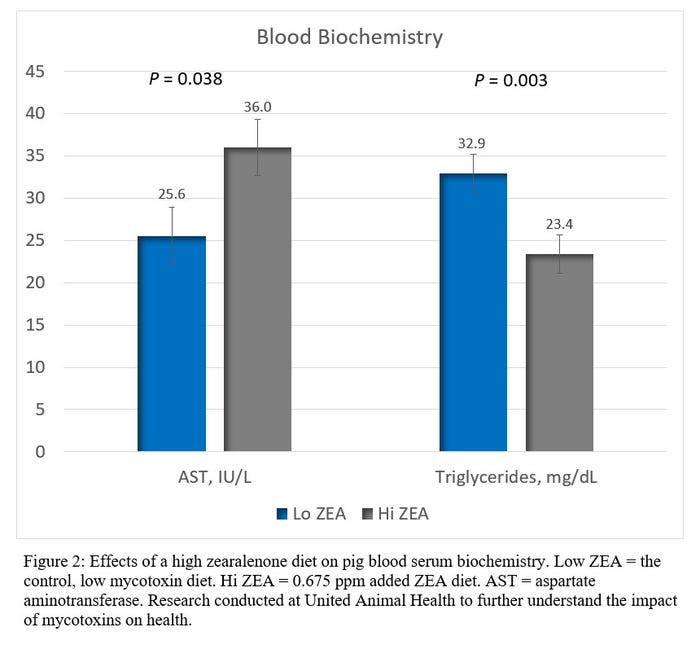Mycotoxins: Don't be fooled by their impact
The effects of zearalenone reach beyond reproductive inefficiency.
October 1, 2020

Sponsored Content
By Julie Mahoney, Ph.D., and Adrienne Woodward, Ph.D., M.B.A., United Animal Health
With the 2020 corn harvest underway, the question of what mycotoxin challenges will be present in the new crop is top of mind. While deoxynivalenol (vomitoxin) and fumonisin are of concern because they reduce growth and impact gut health, they do not disrupt reproductive health, so the production cycle continues mostly unaffected. Zearalenone, on the other hand, largely disrupts reproductive efficiency and can have downstream effects on sow herd performance.
What makes ZEA such a burden to the sow, especially as the toxin is typically found in relatively low concentration compared to DON and FUM? The Food and Drug Administration advisory level for ZEA is only 0.5 parts per million in complete diets, much lower than DON and FUM. Furthermore, why would other animals besides breeding stock be affected by ZEA contamination of the diet? And what can be done to prevent ZEA from causing issues in production systems?
Zearalenone impacts on reproduction
After consumption of ZEA, the toxin is rapidly absorbed into the body primarily through passive transport by the intestinal epithelial cells. Once in the body, ZEA and its metabolites competitively bind estrogen receptors, creating many reproductive issues and visual signs characteristically associated with a ZEA-contaminated diet.
The most visible symptom of ZEA exposure is the swelling of vulvas and mammary glands (Figure 1). However, this swelling of the external genitalia corresponds with a swelling of the entire reproductive tract in a dose-dependent manner due to ZEA1. Increased weight of the uterus and enlargement of the tract disposes gilts and sows to vaginal and/or rectal prolapse. Caretakers also might observe suppressed feed intake, agitation and estrus-like behavior among animals.

As ZEA masquerades through the body as estrogen, normal hormone production is interrupted and secretion of key reproductive hormones such as luteinizing hormone and progesterone is decreased2,3. This can prolong the estrous cycle and delay ovulation, resulting in an inability to get gilts bred, extended wean-to-first-estrus interval in sows and reduced conception rates. Exposure to ZEA during gestation interferes with conceptus development and embryo survivability, leading to abortion, fewer total born numbers and reduced neonatal viability.
Zearalenone impacts beyond reproduction
ZEA's impact on the health of pigs goes beyond the reproductive system of females. Upon uptake by the intestine, ZEA reaches the liver where it exhibits hepatotoxic effects through changes in biochemical markers of liver function. High ZEA in diets increases aspartate aminotransferase, alanine aminotransferase and gamma-glutamyl transpeptidase, all of which are correlated with liver damage and oxidative stress1. High ZEA also lowers blood clotting due to vitamin K deficiency from the reduction of fat digestion and energy availability, as evidenced by a reduction in serum triglycerides (Figure 2).

The immune system is also a victim of ZEA in swine diets. Exposure of cells to high ZEA impairs lymphocyte proliferation4 and increases inflammatory cytokines5. Both these actions leave the animals' immune system compromised and imbalanced, allowing for additional insults — such as a respiratory virus or enteric pathogen — to proceed unchecked as the body's resources fight mycotoxin exposure instead.
Solutions for zearalenone in swine
Altogether, ZEA can both negatively impact reproduction and reduce animal health when present in diets. Both lead to reduced profit, either through lower reproductive efficacy or decreased health and growth performance. However, there are solutions for managing ZEA in swine diets.
Ensuring feed ingredients are low-toxin is the first line of defense; however, since feed quality is variable and rarely mycotoxin-free, product interventions may be useful. Adsorbents, such as aluminosilicate-containing clays, can assist in adsorbing toxins prior to uptake in the gut. Prebiotics, including certain oligosaccharides, are useful as a potential ingredient intervention of ZEA as they also limit uptake through the intestine. Finally, some probiotics have the potential to deactivate or lessen the toxicity of ZEA through cleavage of the toxin's molecular bonds. Finding the solution, or blend of solutions, that works best for each scenario — reproduction or health performance — is key to managing ZEA in swine.
References
Jiang, S.Z., Yang, Z.B, Yang, W.R., Gao, J., Liu, F.X., Broomhead, J., and Chi, F. 2011. Effects of purified zearalenone on growth performance, organ size, serum metabolites, and oxidative stress in postweaning gilts. J. Anim. Sci. 89:3008-3015.
Green, M.L., Diekman, M.A., Malayer, J.R., Scheidt, A.B., and Long, G.G. 1990. Effect of prepubertal consumption of zearalenone on puberty and subsequent reproduction of gilts. J. Anim. Sci. 68:171-178.
Flowers, B., Cantley, T., and Day, B.N. 1987. A comparison of effects of zearalenone and estradiol benzoate on reproductive function during the estrous cycle in gilts. J. Anim. Sci. 65:1576-1584.
Luongo, E., De Luna, R., Russo, R., and Serino, L. 2008. Effects of four Fusarium toxins (fumonisin B1, α-zearalenol, nivalenol and deoxynivalenol) on porcine whole-blood cellular proliferation. Toxicon. 52:156-162.
Taranu, I., Braicu, C., Marin, D.E., Pistol, G.C., Motiu, M., Balacescu, L., Beridan Neagoe, I., and Burlacu, R. 2015. Exposure to zearalenone mycotoxin alters in vitro porcine intestinal epithelial cells by differential gene expression. Toxicol. Lett. 232:310-325.
Statements are based on available published research or on independent trials conducted by or in conjunction with United Animal Health.
About the Author(s)
You May Also Like



